


Framed or unframed, desk size to sofa size, printed by us in Arizona and Alabama since 2007. Explore now.
Shorpy is funded by you. Patreon contributors get an ad-free experience.
Learn more.

- Texas Flyer wanted
- Just a Year Too Soon
- WWII -- Replacing men with women at the railroad crossing.
- Yes, Icing
- You kids drive me nuts!
- NOT An Easy Job
- I wonder
- Just add window boxes
- Icing Platform?
- Indiana Harbor Belt abides
- Freezing haze
- Corrections (for those who care)
- C&NW at Nelson
- Fallen Flags
- A dangerous job made worse
- Water Stop
- Passenger trains have right of way over freights?
- Coal
- Never ceases to amaze me.
- Still chuggin' (in model form)
- Great shot
- Westerly Breeze
- For the men, a trapeze
- Tickled
- Sense of loneliness ...
- 2 cents
- Charm City
- What an Outrage
- Brighton Park
- Catenary Supports
Print Emporium
The Kaiser Comes Calling: 1912
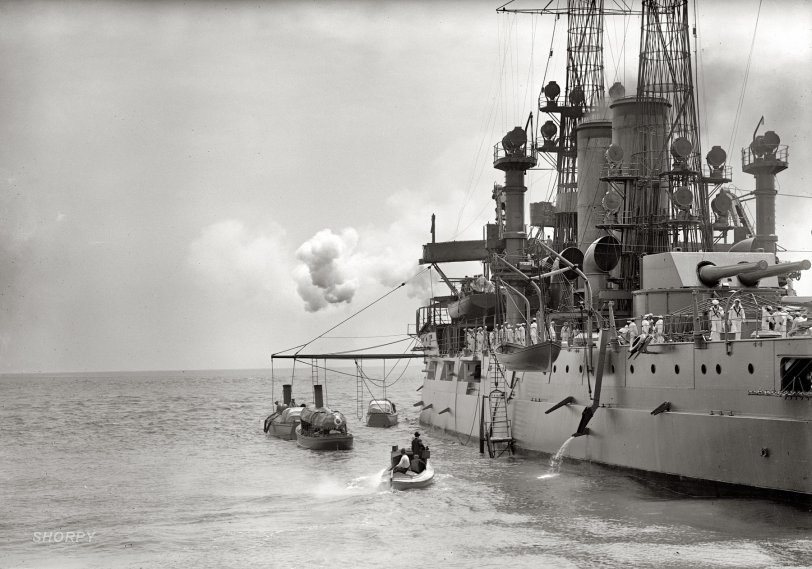
1912. "German port call. U.S. battleship in Hampton Roads to greet German squadron." Harris & Ewing Co. glass negative. View full size | More here.
Thanks Dave!
It puts the top picture really into perspective. It's amazing the differences in design philosophy between the British/German dreadnought battleships and the Americans.
Still didn't stop them from becoming ridiculously obsolescent fast and into scrap in 10 years.
U.S.S. Florida
I salute the battleship geeks!
Seriously, the range of knowledge here is very impressive and much more interesting than the postings of the railfans (I'm one) when a locomotive photograph appears.
Big Guns
Utah, Florida and Delaware all mounted ten 12 inch guns in five turrets. By comparison the last battleships completed for the US Navy, the Iowa class, mounted nine 16 inch guns in three turrets. The biggest guns ever mounted on a battleship where the nine 18 inch guns in three turrets on the Japanese Yamato class. In fact the Japanese were actually planning a "Super Yamato" class with 20 inch guns.
Cage Masts
Cage masts, found on every battleship built in the USA from about 1910 to 1920, allowed spotters to direct artillery fire. The structure was designed to take multiple hits from enemy fire without collapsing.
Cagy Question
Can anyone explain what the purpose of the two cages on either side of the smoke stacks? What were used they were for? Just a fancy ladder?
USS Florida
USS Florida and USS Utah would have both been a year old at the time of the photo. SMS Moltke would have been the same age. They all had 10 280mm main guns for the main batteries.
The Main Guns
The ship looks relatively new. How big are the main guns? They look surprisingly small compared to the monsters that were on the WWII battleships.
"Firing Salutes back and forth"
Somehow, I have this eerie feeling about reading the article and seeing the future foes, only 5 years from combat against each other, fired salutes back and forth at each other.
I get the impression that hilarity would have ensued if the article had ended with something along the lines of:
"After a rollicking 10 gun salute from USS Florida, followed by an additional 10 gun salute from USS Utah was answered by SMS Moltke's own 10 round salute, the enthusiastic friends continued to salute each other for the next few hours until Moltke lit off a massive pyrotechnic display near her forward armory and then slipped off, to the delight and cheers of the men of Florida, Utah, and Deleware.
In an unrelated story, 1053 sailors from SMS Moltke were lost in a freak training accident off the Virginia Capes. The US Navy is currently enroute to look for survivors."
Lynnhaven Bay
Just wanted to put this out; the article quoted cannot be completely correct. There is no possibility that at the time a new capital ship such as Moltke or her two escorts could have entered Lynnhaven Bay; Lynnhaven Bay's shallow channel allowed sailing ships of 8-11 foot draft to enter, but Moltke would have drawn 16-18 feet, minimum, as a cruiser-battleship highbred (a type which would eventually be called a Battlecruiser).
In addition, Lynnhaven Bay does not, technically, open into Hampton Roads, but is located almost literally at the mouth of the Chesapeake; Hampton Roads, proper, is some 5 miles further north, beyond the small bay at Littlecreek (which is now a US Naval Amphibious base, and is the the far right star shaped bay on the Wikipedia entry's photo of Hampton Roads).
[Or, the fault may lie in incomplete knowledge on our part about the Lynnhaven Bay of 100 years ago. The "Movements of Naval Vessels" columns in the Washington Post and New York Times from 1900 to the 1920s contain dozens of references to battleships at Lynnhaven Bay. Below are some examples from 1910-1915. - Dave]
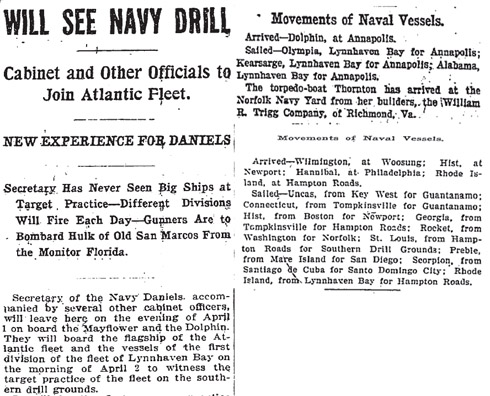
Meeting the Moltke
Washington Post Jun 3, 1912
Norfolk Va., June 2 - The American battleships Utah, Delaware, and Florida exchanged salutes with the German cruiser-battleship Moltke this afternoon as the three former ships sped through the Virginia capes en route to Hampton Roads.
The firing of the salutes on Sunday is not customary, naval officers say, and the fact the the Utah, which led the three American ships as they passed the capes, boomed a salute to Rear Admiral von Reuber Paschwitz, commanding the German squadron, was regarded as an unusual compliment for the German commander.
The big guns of the Moltke answered the salutes from the Utah, and the officers and crew lined the decks and waved their hats to the American ships.
Everything is in readiness for the visit of President Taft in the Hampton Roads tomorrow. The German ships are expected to leave Lynnhaven Bay about 7 o'clock tomorrow morning so as to arrive in Hampton Roads about the same time the Mayflower gets in with President Taft.
U.S.S. Florida
The battleship is either the USS Florida or the USS Utah. The Florida was scrapped in 1932. The Utah was sunk at Pearl Harbor.
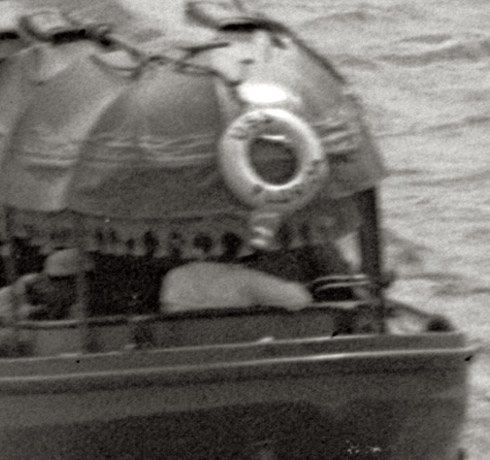
Enlightened
Jughead may be on to something but most of the lights here have the main function of searchlights. They certainly could be for signaling but strict signal lamps were usually smaller, more nimble, and located in proximity to the bridge (or conning tower on this pre-WWI ship) or signal station. Even the smaller signal lamps could reach the horizon day or night though that was not always a good thing.
The larger searchlights were generally for utility (e.g. cargo operations), emergency (e.g. man overboard or other search and rescue), or during warfare for night action (e.g., WWI against torpedo boats, WWII Battle of Savo Island). Radar changed the game and the need for banks of lights.
Slop chute
They're firing a saluting gun in honor of the dignitary. You'd think a visiting honcho wouldn't have to boat through the bilge discharge and they'd at least hoist the slop-chute inboard for the duration of the salute and coming up the side. Curious what ship this is. And yes, those searchlights all had radial shutters that could be opened to transmit blinker-messages in morse. There were a lot of them because they were subject to gunfire, being mostly glass.
Two guns fired there
That's one way to signal. How cool that the shot was taken at that time.
Searchlights Galore
In the pre-radar days, men o'war sported lots of searchlights.
[Were any of these used for signaling? - Dave]
























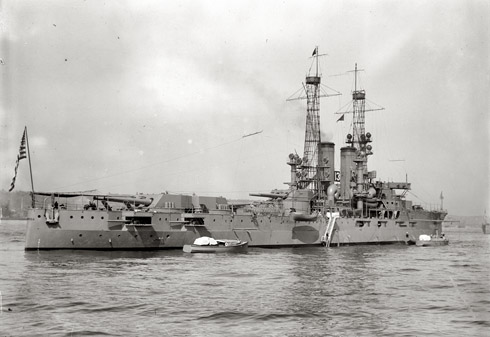
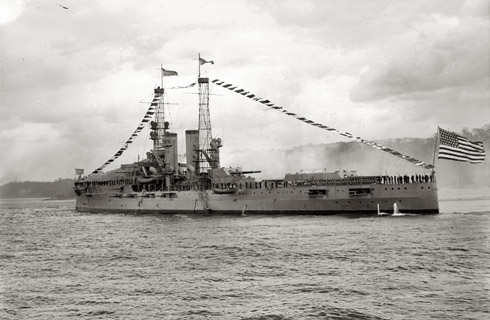
On Shorpy:
Today’s Top 5